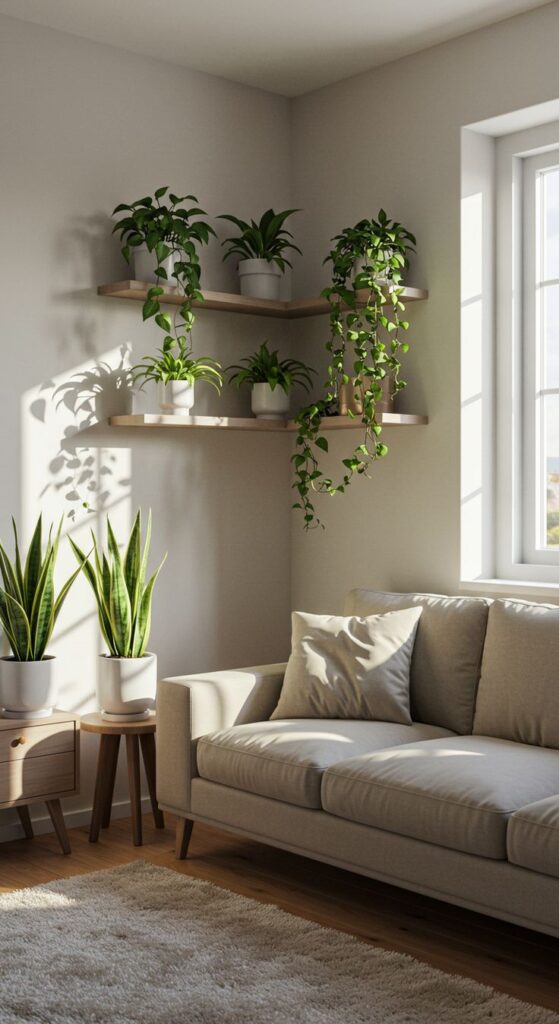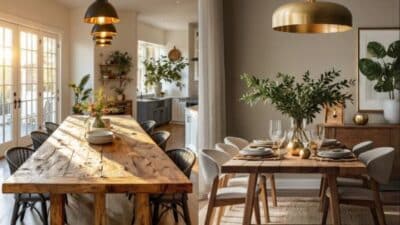Bringing indoor plants into your home can significantly enhance your living space, both visually and atmospherically. Indoor plants improve air quality and create a calming environment, making your home healthier and more inviting. They come in many varieties, suited to different light conditions and care levels, allowing you to find the perfect fit for your lifestyle.
Choosing the right plants involves understanding the specific needs of each species, including light, water, and humidity preferences. Proper placement and routine care will help your plants thrive and add lasting beauty to your rooms.
By learning simple care techniques and identifying potential issues early, you can enjoy the benefits of indoor greenery without hassle. Whether you’re new to houseplants or expanding your collection, a thoughtful approach makes all the difference.
Key Takeways
- Select plants that match your home’s light and humidity levels.
- Regular care and proper placement boost plant health and longevity.
- Early problem identification helps prevent common indoor plant issues.


Benefits of Indoor Plants
Indoor plants offer practical advantages that affect your environment, mood, and living space. They improve the air you breathe, influence your mental state, and add visual appeal to your home.
Improving Air Quality
Indoor plants can help reduce airborne toxins by absorbing pollutants like formaldehyde, benzene, and trichloroethylene. This process improves the air composition inside your home, making it fresher and safer to breathe.
Plants also increase humidity through transpiration, which can lessen respiratory problems and dry skin, especially in heated or air-conditioned spaces. While they don’t replace ventilation or air purifiers, adding several plants in key areas can meaningfully contribute to better indoor air.
Many homes and offices across the city enjoy the benefits of Sydney indoor plant hire, a service loved for making indoor spaces feel fresher, greener, and effortlessly styled.
Enhancing Mood and Well-Being
Having plants indoors can reduce stress and anxiety by creating a calming presence. You may notice improved focus and productivity when plants are nearby, which supports mental clarity during work or study.
Interacting with plants by watering or arranging them can be therapeutic, helping to lessen feelings of loneliness or depression. These effects have been observed in various studies showing lowered depressive moods and reduced sick leave among people exposed to indoor greenery.
Aesthetic Value
Indoor plants bring natural color and texture to your home environment. They can complement your decor style, creating a more inviting and lively space.
You can use different plant shapes and sizes to define areas or fill corners, making your home feel more organized and cared for. The visual connection to nature also improves your enjoyment of the room without requiring significant changes to your existing setup.


Choosing the Right Indoor Plants
When selecting plants for your home, you need to consider growth conditions, care difficulty, and safety for pets. Matching plant types to your environment and lifestyle will help ensure healthy, thriving greenery.
Best Plants for Beginners
If you’re new to indoor gardening, choose plants that require minimal care and tolerate occasional neglect. Snake plants, pothos, and spider plants are ideal because they withstand irregular watering and adapt to different light levels.
These plants don’t need frequent fertilizing or pruning, making them easy to maintain. Their resilience reduces the risk of failure, encouraging you to continue building your indoor garden.
Low-Light Options
Your plant choice depends largely on available natural light. For rooms with limited sunlight, select species like ZZ plants, cast iron plants, or peace lilies. These plants can survive and grow in shaded corners or rooms with indirect light.
Avoid placing sun-loving plants in low-light areas, as they will struggle or die. Choosing one suited to low light will save you stress over constant care adjustments.
Pet-Friendly Choices
If you have cats or dogs, ensure your plants are non-toxic. Safe options include Boston ferns, areca palms, and certain types of orchids. These plants won’t harm your pets if ingested.
Keep toxic plants like philodendrons or dieffenbachias out of reach, or avoid them altogether. Prioritizing pet safety helps you enjoy plants without risking your pets’ health.
Air-Purifying Varieties
Some indoor plants improve air quality by filtering toxins like formaldehyde, benzene, and carbon monoxide. Examples include aloe vera, rubber plants, and English ivy.
Including these in your home can aid air quality and create a fresher environment. Ensure these plants receive proper care to maintain their purifying effects over time.


Placement and Light Requirements
Proper placement of your indoor plants depends mostly on the amount and type of light they need. Understanding which rooms and windows offer the right light intensity and duration will keep your plants healthy.
Identifying Optimal Locations
Look for windows that match your plant’s light needs. South- and west-facing windows provide the strongest light, suitable for high-light plants like succulents. East-facing windows offer moderate light, good for medium-light plants such as pothos. North-facing windows give low light, fitting for shade-tolerant varieties like snake plants.
Measure the distance from the window. For medium-light plants, place them about five to eight feet from south or west windows. Low-light plants may thrive farther inside the room, away from direct sunlight. Avoid placing plants in spots where sunlight is blocked by curtains or furniture.
Adjusting for Different Light Levels
High-light plants require at least 4-6 hours of direct or very bright indirect sunlight daily. You can place them near south or west windows to meet these needs. Medium-light plants often do well in bright, indirect light with 6-8 feet of separation from the window.
Low-light plants tolerate limited natural light but benefit from consistent exposure. Northern windows or rooms with just artificial light work for these species. Use supplemental grow lights if natural light is insufficient, aiming to mimic the duration and intensity typical of your plant’s natural environment.
Common Mistakes in Placement
One common mistake is placing plants too far from their light source, causing leggy growth and leaf drop. Another is exposing low- or medium-light plants to direct sunlight, which can scorch leaves.
Avoid sudden changes in light exposure; plants need gradual adjustment. Also, don’t ignore room temperature and drafts near windows, as these impact plant health alongside light. Check your plant regularly to ensure the location still suits its needs as seasons change.


Indoor Plant Care Essentials
Proper care requires attention to watering methods, soil choice, and feeding schedules to keep your plants healthy and thriving. Managing moisture levels, selecting the right pot and soil, and providing essential nutrients are critical to avoid common issues like root rot.
Watering Techniques
Watering is crucial, but both overwatering and underwatering can harm your plants. Check the soil moisture before watering by inserting your finger 1-2 inches into the soil. If it feels dry, it’s time to water. Avoid letting water sit in the saucer under the pot to prevent root rot.
Use room temperature water to avoid shocking roots. Water thoroughly until it drains from the bottom, ensuring the entire root system receives moisture. Adjust watering frequency based on plant type, season, and environment. Consider tools like moisture meters for more precise readings.
Soil and Pot Selection
Choosing the right soil ensures proper drainage and oxygen access to roots. Use a potting mix that matches your plant’s needs, such as cactus mix for succulents or peat-based for tropical plants. Avoid garden soil, which is too dense and can cause root rot.
Select pots with drainage holes to release excess water. The pot size should match your plant’s root system; too large can retain excess moisture, leading to rot. Consider pots with breathable materials like terracotta for better air circulation.
Fertilizing Practices
Your indoor plants need nutrients to grow but over-fertilizing can damage roots. Use a balanced, water-soluble fertilizer formulated for houseplants, applying it during the growing season (spring and summer).
Follow label instructions carefully, generally fertilizing every 4-6 weeks. Avoid fertilizing dormant plants in winter to prevent nutrient buildup. Organic options and slow-release fertilizers provide steady nutrition and are less likely to cause stress to your plants.


Troubleshooting Common Indoor Plant Problems
Indoor plants can face several challenges that affect their health and growth. Identifying the cause quickly helps you apply the right solution to keep your plants thriving.
Pests and Diseases
Check your plants regularly for pests like spider mites, aphids, and mealybugs. These insects cause leaf discoloration, sticky residue, or webbing. Use a magnifying glass to spot tiny pests early.
Fungal diseases often appear as spots on leaves or powdery mildew. Root rot is a severe issue caused by fungal infection from overwatering, leading to black, mushy roots and a foul smell.
Treat pests with insecticidal soap or neem oil. For root rot, remove affected soil and roots, then repot in fresh, well-draining soil. Avoid waterlogged conditions to prevent recurrence.
Overwatering and Underwatering
Too much water drowns roots and causes root rot. Symptoms include yellowing leaves, soft stems, and a sour or musty smell from soil. Check soil moisture before watering by inserting your finger about an inch deep.
Underwatering leads to dry, crispy leaves and slow growth. Leaves may wilt or drop as the plant conserves water. If soil is dry to the touch, increase watering frequency gradually.
Balance revolves around your specific plant’s needs—some prefer evenly moist soil, others require drying out between waterings. Use pots with drainage holes to avoid standing water.
Recognizing Signs of Stress
Yellow leaves can signal overwatering, nutrient deficiency, or low light. Drop leaves may indicate sudden changes in environment, temperature stress, or underwatering.
Curling or brown leaf tips often result from dry air, fertilizer burn, or inconsistent watering. Wilting leaves can mean either over- or underwatering, so always check soil condition first.
Use a simple checklist to identify the issue:
- Soil moisture level
- Light exposure
- Signs of pests or disease
- Recent care changes
Adjust care based on these observations to restore plant health.
- 15shares
- Facebook0
- Pinterest15
- Twitter0



